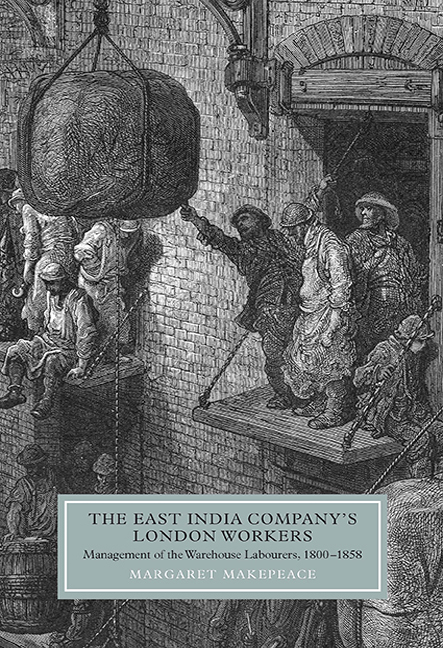Book contents
- Frontmatter
- Contents
- Figures and tables
- Dedication
- Acknowledgements
- Abbreviations
- 1 Introduction
- 2 The East India Company Warehouses
- 3 The Warehouse Labourers
- 4 Management Strategies: Incentives, Rewards and Benevolence
- 5 Management Strategies: Systems of Internal Control
- 6 The Royal East India Volunteers: The ‘Union of Civil and Military Dependence’
- 7 The Relationship Between the East India Company and its London Warehouse Labourers
- 8 The Warehouse Closures
- 9 Management of the Warehouse Labourers and Pensioners 1838–1858
- Conclusion: ‘Good Masters to the Lower Class of Their Dependents’
- Bibliography
- Index
- Frontmatter
- Contents
- Figures and tables
- Dedication
- Acknowledgements
- Abbreviations
- 1 Introduction
- 2 The East India Company Warehouses
- 3 The Warehouse Labourers
- 4 Management Strategies: Incentives, Rewards and Benevolence
- 5 Management Strategies: Systems of Internal Control
- 6 The Royal East India Volunteers: The ‘Union of Civil and Military Dependence’
- 7 The Relationship Between the East India Company and its London Warehouse Labourers
- 8 The Warehouse Closures
- 9 Management of the Warehouse Labourers and Pensioners 1838–1858
- Conclusion: ‘Good Masters to the Lower Class of Their Dependents’
- Bibliography
- Index
Summary
the english East India Company functioned for more than 250 years, and its complex history is made up of many interwoven strands reflecting the wide scope of its activities: commercial, maritime, military, administrative, political and imperial. It is therefore perhaps inevitable that some aspects of the Company's history have been overlooked or neglected. This study fills one of the major gaps in the historiography of the East India Company by providing a detailed examination of the strategies used by the Company to manage the thousands of labourers who worked in its London warehouses between 1800 and 1858, and by showing how benevolence formed an integral part of the Company's domestic business practices. It analyses the composition of the ware-house workforce and explores in depth the labourers’ experience of working for the Company.
The East India Company: an outline history
By 1800 the East India Company was a commercial organization of unrivalled size and complexity, playing a key role in the British economy. It supplied Asian commodities for the home market; employed many staff on its domestic, overseas and marine establishments; and provided a livelihood to manufacturers, tradesmen, shipbuilders and suppliers of a wide variety of stores and export goods. The Company had evolved from a small enterprise run by a group of City of London merchants which, in 1600, had been granted a royal charter conferring the monopoly of English trade in the whole of Asia and the Pacific. At its outset the East India Company was interested in the commercial opportunities offered by the spice islands of Southeast Asia rather than India, and it raised a capital of £68,373 by subscription to send four ships to Bantam and Sumatra in 1601. Following the success of this first voyage, the Company sent out eleven more fleets to Bantam between the years 1604 and 1613. The average profit on the voyages in 1601–12 was 155 per cent.
For a large part of the seventeenth century, pepper from Southeast Asia was the chief commodity traded by the Company as it strove to maintain a share of the market despite strong opposition from the Dutch.
- Type
- Chapter
- Information
- The East India Company's London WorkersManagement of the Warehouse Labourers, 1800–1858, pp. 1 - 16Publisher: Boydell & BrewerPrint publication year: 2010



